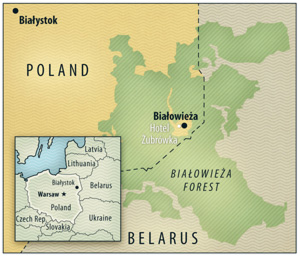sierraclub.org - sierra magazine - july/august 2012 - escape: to a polish primeval forest

Jenny Adams
Bialowieza Forest, Poland
WHERE
Bialowieza, Poland
HOW MUCH
About $150 per night for a double room at Hotel Zubrowka; about $45 for a four-person carriage ride through Bialowieza Forest
MORE
hotel-zubrowka.pl
GETTING THERE In Warsaw, board an old, stark train
that scoffs at the word "frill." Rumble through wooded
countryside for two and a half hours, detraining in the quaint city of Bialystok. Buy playing cards at the Polish equivalent of a 7-Eleven—you'll need them to take your mind off the lack of legroom during the three-hour bus ride to the village of Bialowieza, which abuts the primeval forest. Check into Hotel ubrowka and sweat away all thoughts of lingering Soviet Bloc deprivation in the sauna.
BEST MOMENT Sipping a cocktail called szarlotka from a flask while a massive draft horse pulled our carriage through a forest as green as a cartoon emerald. The drink combines apple juice with vodka infused with local sweetgrass. It smells like freshly cut hay and goes down much too easily.
WORST MOMENT Realizing that the untouched primeval forest is a breeding ground for the planet's most aggressive mosquitoes. The swarm descended from the canopy like a cloud of black dust and left no exposed skin unbitten.
FAVORITE CHARACTER The wisent, a species of bison that grows to nine feet tall and 2,000 pounds and once roamed Europe's lowland plains in endless herds. Polish kings declared the beasts their property, so they were relatively protected in the Bialowieza Forest, which was a royal hunting retreat. In World War I, though, most were killed by the Germans. Soon after, scientists started a program to reintroduce wisents, and more than 800 exist in the wild today.
 Map by Peter and Maria Hoey
Map by Peter and Maria Hoey
LOCAL LORE More than 2,000 years ago, Greek historian Herodotus waxed poetic about the wild tarpans (feral horses) grazing the fields that now make up modern-day Poland. The tarpans, which had dun coats and distinctive black ridges down their backs, became extinct in 1879. Yet today, tarpan doppelgaengers roam the Bialowieza, wearing icicles in their winter manes like badges of immortality. The look-alikes are the product of an experiment by Nazi zoologists who tried to resurrect extinct species by mating half-breeds that resembled their pure-blood ancestors.
WHAT'S GREEN The Bialowieza is a UNESCO World Heritage site with strict rules of engagement for the 150,000 or so visitors who tour the forest each year. Licensed guides are required, and you can travel only by foot, bike, ski, or horse-drawn carriage.
WHAT'S NOT GREEN Beyond the park's boundaries are another 120,000 acres of forest. That portion is under different management, and sections of it are subjected to logging.
PLANET SAVING OPPORTUNITIES
Write a letter to UNESCO about your time in the Bialowieza and urge it to continue its work to extend the boundaries of the existing park and thus protect more of the forest from logging practices now in place. —Jenny Adams